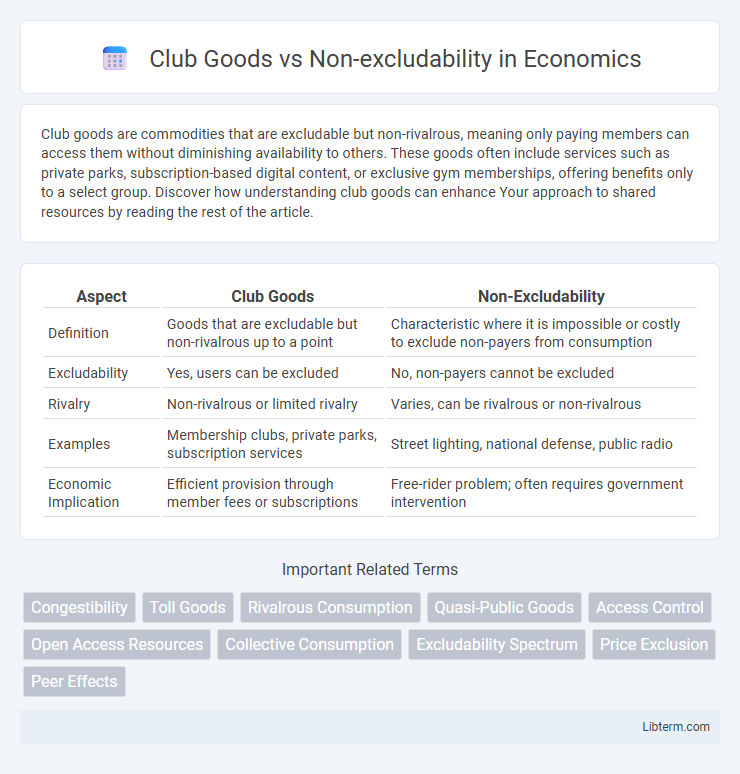Club goods are commodities that are excludable but non-rivalrous, meaning only paying members can access them without diminishing availability to others. These goods often include services such as private parks, subscription-based digital content, or exclusive gym memberships, offering benefits only to a select group. Discover how understanding club goods can enhance Your approach to shared resources by reading the rest of the article.
Table of Comparison
| Aspect | Club Goods | Non-Excludability |
|---|---|---|
| Definition | Goods that are excludable but non-rivalrous up to a point | Characteristic where it is impossible or costly to exclude non-payers from consumption |
| Excludability | Yes, users can be excluded | No, non-payers cannot be excluded |
| Rivalry | Non-rivalrous or limited rivalry | Varies, can be rivalrous or non-rivalrous |
| Examples | Membership clubs, private parks, subscription services | Street lighting, national defense, public radio |
| Economic Implication | Efficient provision through member fees or subscriptions | Free-rider problem; often requires government intervention |
Introduction to Club Goods
Club goods are a category of goods characterized by excludability but non-rivalrous consumption, meaning individuals can be prevented from accessing them while usage by one does not reduce availability to others. Examples include private parks, subscription-based streaming services, and toll roads, where access is restricted but simultaneous consumption is possible. This contrasts with pure public goods, which are both non-excludable and non-rivalrous, highlighting the unique position of club goods in economic theory.
Understanding Non-Excludability
Non-excludability refers to a characteristic of goods where it is not feasible to prevent individuals from accessing or using them once provided. Club goods, unlike purely non-excludable goods, exhibit partial excludability by allowing providers to restrict access to paying members, creating a controlled usage environment. This distinction highlights the challenge in managing free-rider problems associated with non-excludable goods since exclusion mechanisms are ineffective or costly.
Key Differences Between Club Goods and Non-Excludable Goods
Club goods are characterized by excludability and non-rivalry, meaning access can be restricted while consumption by one individual does not reduce availability for others. Non-excludable goods cannot prevent individuals from using them, though they may be rivalrous or non-rivalrous in consumption. The key difference lies in excludability: club goods allow controlled access to users, whereas non-excludable goods are freely accessible to all without exclusion mechanisms.
Characteristics of Club Goods
Club goods are characterized by their excludability and non-rivalrous consumption up to a certain capacity, allowing providers to restrict access while efficiently serving multiple users simultaneously. These goods maintain a balance between public benefits and private control, often seen in services like subscription-based streaming platforms or private parks. The main challenge lies in managing congestion and ensuring optimal usage without diminishing the value for existing members.
Real-World Examples of Club Goods
Club goods, such as subscription-based streaming services like Netflix and private golf courses, demonstrate non-rivalrous consumption but incorporate excludability by limiting access to paying members only. These goods maintain quality and availability by preventing non-payers from using the service, contrasting with pure public goods that cannot exclude users. Examples like gated communities and private Wi-Fi networks highlight how excludability sustains club goods, ensuring controlled consumption and reducing congestion.
Challenges Posed by Non-Excludability
Non-excludability in public goods leads to significant challenges such as free-riding, where individuals consume resources without contributing to their provision. This issue undermines the sustainability of club goods, which rely on controlled access to maintain quality and funding. Overcoming non-excludability demands innovative mechanisms like membership fees or technological barriers to ensure effective resource management and equitable usage.
Efficiency and Access in Club Goods
Club goods exhibit partial non-excludability, allowing members exclusive access while preventing outsiders, which enhances allocative efficiency by reducing congestion and optimizing resource use. This controlled access balances efficient consumption with high-quality service provision, avoiding the overuse typical in pure public goods. Efficiency in club goods is maximized when membership fees reflect marginal costs, ensuring access aligns with demand without diminishing benefits for existing users.
Managing Non-Excludable Resources
Managing non-excludable resources requires strategies to prevent overuse and depletion, addressing the core issue of non-excludability that leads to free-rider problems. Club goods, characterized by excludability and non-rivalrous consumption, demonstrate how access control through membership fees or licenses can effectively regulate the use of shared resources. Implementing monitoring systems and usage restrictions ensures sustainable management and mitigates the tragedy of the commons often associated with non-excludable goods.
Implications for Public Policy
Club goods are characterized by excludability and non-rivalrous consumption up to a congestion point, making them suitable for subscription-based public services like toll roads or private parks. Non-excludability in pure public goods challenges policymakers by necessitating government intervention to prevent free-rider problems and ensure efficient resource allocation. Designing policies requires balancing access control and funding mechanisms to optimize social welfare while managing congestion and funding sustainability.
Conclusion: Club Goods versus Non-Excludability
Club goods exhibit the characteristic of excludability, allowing providers to restrict access and manage consumption efficiently, which differentiates them from non-excludable goods that anyone can use without exclusion. This excludability enables club goods to mitigate free-rider problems often associated with non-excludable resources, ensuring sustainability and optimal resource allocation. Consequently, understanding the excludability dimension is crucial in designing effective policies and economic models that address resource management and public welfare challenges.
Club Goods Infographic

 libterm.com
libterm.com